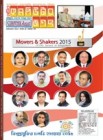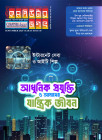হোম >
লেখক পরিচিতি
লেখকের নাম:
কাজী সাঈদা মমতাজ
মোট লেখা:১৮
লেখা সম্পর্কিত
পাবলিশ:
২০১৬ - জানুয়ারী
তথ্যসূত্র:
কমপিউটার জগৎ
লেখার ধরণ:
প্রতিবেদন
তথ্যসূত্র:
ইংরেজি সেকশন
ভাষা:
ইংরেজি
স্বত্ত্ব:
কমপিউটার জগৎ
MIS and Computers
Actually, there is no clear cut dividing line between the use of computer in any organization. The use of computer in any organization. will be outlined in two broad categories:
The routine processing of day-to-day transactions, known as data processing or transaction processing.
The use of computers by the end-users themselves: The end users include; managers, accountants, office staff, sales people, executives and others.
Both data processing and end-user computing produce management information. The key difference is that data processing systems 'supply pre-determined outputs and reports so there is less flexibility. This means that great care must be taken in analyzing and determining management's real information needs before the system is designed. On the other hand with end-user computing there is more flexibility and interaction so that the emphasis becomes one of the supporting the end-user rather than the production of a specified report.
Data processing systems
These systems perform the essential role of collecting and processing the dailytransactionsof the organization.
Transaction processing is substantially more significant in terms of processing time, volumeof input and output than say, information production for tactical and strategic planning.Transaction processing is essential to keep the operations of the organization runningsmoothly and provides the base for all other internal information support.
Transaction processing is necessary to ensure that the day-to-day activities of theorganization- ore processed, recorded and added upon. Files are maintained which provideboth the current data for transactions.
Transaction processing can be sub-divided into:
a) Current activity processing
b) Report processing
c) Query processing
The Database Management system is a complex software system which construct, expandsand maintains the database. It also provides the link, or interface, between the user and thedata in the base.
The three primary categories of DBMS are:
● Relational DBMS .
Where each type of record is represented as existing in a table or file of like records. Forexample, these could be Road Data, Bridge Data and so on.
● Hierarchical
This is system having in built linkages whereby there are ‘owner’ records which ‘own’numerous ‘member’ records.
● Network
These are further developments of linkage systems with many more record types andlinkages.
Both the linkage systems require the user to know what linkages have established in order toknow on what basis data can be retrieved.-The linkage systems are technically more efficientbut do require greater data processing knowledge so their use tends to be restricted toinformation specialists.
The ability to store and access vast amounts of data in an efficient manner is being used torefine and improve activities at strategic, tactical and operational levels.
● Transaction processing systems are pre-specified and changes require theintervention of system specialists.
● Transaction processing comprises: activity Processing, report processing and enquiryprocessing.
● A database is a collection of data, available to all, which is independent of individualprograms. _
● A Data Base Management System (DBMS) is the software which controls thedatabase and which acts as a link between the users and the database.
● A DBMS comprises software for organizing data, retrieving data and handlingenquiries. “
● Decision support systems are operated by the end userand supplement humanjudgment in semi-structured decision making.
● Decision support packages include: modeling, spread sheets, forecasting, linearprogramming, statistical analysis, expert systems and so on.
Spread sheet packages can be used for transaction processing and for modeling in decision support systems.
Expert systems aim to incorporate human judgment and experience into a knowledge base.
Executive Information Systems are easy to use data retrieval systems in which the executive can drill down for data.
Prototyping means obtaining experience from using a prototype which is refined to produce a working system.
Information centers provide a support and advisory service.
Technology, including IT, influences jobs, relationships and organization structures.
l. Artificial Intelligence by Elaine rich, Kevin knight.
2. Management Information Systems by T Lucey.
The routine processing of day-to-day transactions, known as data processing or transaction processing.
The use of computers by the end-users themselves: The end users include; managers, accountants, office staff, sales people, executives and others.
Both data processing and end-user computing produce management information. The key difference is that data processing systems 'supply pre-determined outputs and reports so there is less flexibility. This means that great care must be taken in analyzing and determining management's real information needs before the system is designed. On the other hand with end-user computing there is more flexibility and interaction so that the emphasis becomes one of the supporting the end-user rather than the production of a specified report.
Data processing systems
These systems perform the essential role of collecting and processing the dailytransactionsof the organization.
Transaction processing is substantially more significant in terms of processing time, volumeof input and output than say, information production for tactical and strategic planning.Transaction processing is essential to keep the operations of the organization runningsmoothly and provides the base for all other internal information support.
Transaction processing is necessary to ensure that the day-to-day activities of theorganization- ore processed, recorded and added upon. Files are maintained which provideboth the current data for transactions.
Transaction processing can be sub-divided into:
a) Current activity processing
b) Report processing
c) Query processing
The Database Management system is a complex software system which construct, expandsand maintains the database. It also provides the link, or interface, between the user and thedata in the base.
The three primary categories of DBMS are:
● Relational DBMS .
Where each type of record is represented as existing in a table or file of like records. Forexample, these could be Road Data, Bridge Data and so on.
● Hierarchical
This is system having in built linkages whereby there are ‘owner’ records which ‘own’numerous ‘member’ records.
● Network
These are further developments of linkage systems with many more record types andlinkages.
Both the linkage systems require the user to know what linkages have established in order toknow on what basis data can be retrieved.-The linkage systems are technically more efficientbut do require greater data processing knowledge so their use tends to be restricted toinformation specialists.
The ability to store and access vast amounts of data in an efficient manner is being used torefine and improve activities at strategic, tactical and operational levels.
● Transaction processing systems are pre-specified and changes require theintervention of system specialists.
● Transaction processing comprises: activity Processing, report processing and enquiryprocessing.
● A database is a collection of data, available to all, which is independent of individualprograms. _
● A Data Base Management System (DBMS) is the software which controls thedatabase and which acts as a link between the users and the database.
● A DBMS comprises software for organizing data, retrieving data and handlingenquiries. “
● Decision support systems are operated by the end userand supplement humanjudgment in semi-structured decision making.
● Decision support packages include: modeling, spread sheets, forecasting, linearprogramming, statistical analysis, expert systems and so on.
Spread sheet packages can be used for transaction processing and for modeling in decision support systems.
Expert systems aim to incorporate human judgment and experience into a knowledge base.
Executive Information Systems are easy to use data retrieval systems in which the executive can drill down for data.
Prototyping means obtaining experience from using a prototype which is refined to produce a working system.
Information centers provide a support and advisory service.
Technology, including IT, influences jobs, relationships and organization structures.
l. Artificial Intelligence by Elaine rich, Kevin knight.
2. Management Information Systems by T Lucey.
পাঠকের মন্তব্য



